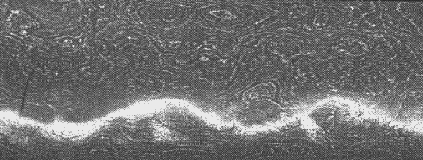

Hada is the 'grain' pattern on the surface of a Japanese blade. It is formed during the initial construction process where the steel billet which will eventually become the sword is repeatedly forged and folded. The resulting hada indicates the techniques which the smith used to make the blade. To show its hada a Nihontô needs to be in good polish (i.e. professional Japanese polish). Do not attempt to polish a Japanese blade yourself. It will not reveal the hada and could reduce its value to zero.
The patterns shown here are basic forms. These forms can vary in size of grain or density, and a particular blade may exhibit more than one form. For instance a characteristic of the Shikkake school of Yamato province is the presence of mokume hada combined with masame hada running along the hamon. Combinations of particular hada types are also a defining characteristic of many other schools and smiths. Additional names are used for these hada combinations
chû = medium Ko = small Ô = large
These qualifying terms are used in conjunction with the main terms below for greater precision in describing the appearance of the hada, e.g. koitame = small itame, Ômokume = large mokume etc
There is often confusion amongst newcomers between the number of times a Japanese blade has been folded and the number of layers which it has. It can be seen that a blade folded once has two layers, one folded twice has four layers. Following this sequence a blade folded fifteen times will have 32,768 layers. It is pointless folding a blade more than around eighteen times (262,144 layers), as the discrete structure of each layer is lost and the steel takes on an homogeneous structure, which is the structure it had to begin with.

Masame hada is produced when the steel billet is repeatedly folded over in the same direction with the sides of the billet being used to form the face of the blade. The lines seen in the grain therefore represent the 'stack' of layers formed during the forging process.

Ayasugi hada is basically masame hada which has been distorted by systematically varying the strength of the hammer blows along the blade during forging.

Itame hada is produced by folding the billet in either the same or alternate directions during forging and using the face of the billet to make the face of the blade.

Mokume hada is basically itame hada which has been changed by using hammer blows of varying strength to produce the characteristic 'whorls'.
Nashiji means "pear skin" and is a dense form of komokume hada with much jinie (surface nie)
Konuka means "rice bran". This is a more coarse form of nashiji hada with less jinie. It is typical of some swords from Hizen province
Muji means a "plain" or "unfigured" ji (blade surface). This is a hada with a very small, very tight pattern which is very difficult to discern. This term can cause confusion in that it is sometimes also used by some sources to refer to the ji of shôwatô and many WWII machine-made shinguntô blades which are constructed from unfolded steel and which therefore have no hada at all.
For an excellent detailed description of the construction of Japanese swords see:
Kapp L. & H., & Yoshindo Yoshihara (1987) 'The Craft of the Japanese Sword'
Tokyo. Kodansha International.
ISBN 0-87011-798-X